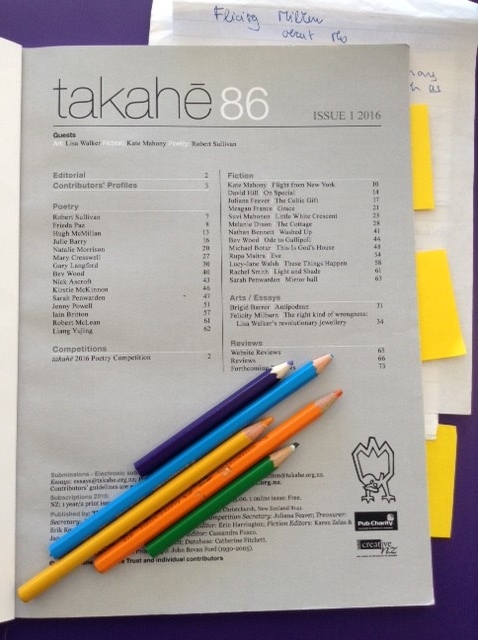Why would one read a literary magazine in the time when novels are still the hottest form on the scene? Because reading a literary magazine is like being young and ready to fall in love every day fresh. You can pick up the read you fancy, and if you realize you made a wrong judgement, you can very easily let it go, because - guess what? There is another one waiting for you when you turn the page. No hard feelings, no strings attached!
Takahē is a New Zealand literary magazine published in Christchurch and has been on the scene since 1989. Its core repertoire consists of short stories, poetry and art by New Zealand writers and artists, and often extends to essays, interviews and book reviews. The magazine is a good starting point for emerging literary talents and offers a place for their first public appearance along with established writers.
Takahē is published twice a year in a print form (in April and December) and as an online issue in August.
One of the prevailing themes of April 2016's issue is motherhood, or the biological and relational obstacles preventing motherhood. Lucy-Jane Walsh (These Things Happen) brings a fresh insight into a life of a young woman who cannot have a child but forms an unusual friendship with someone else’s (at the same time it cleverly captures the nuances of the craziness and obsessiveness of modern parenthood). Suvi Mahonen in Little White Crescent dives into details of medical checks and scans of a pregnant future mother, while much more darker side of deficient pregnancy comes to life in Meagan France’s Grace.
The other topic that floats up to the surface is – of course – love, or various forms of love and its cousins (David Hill’s On Special, Melanie Dixon’s The Cottage, Sarah Penwarden’s Mirror Ball, Rupa Maitra’s Eve).
The second topic that recurs is writing (The Celtic Gift by Juliana Feaver and Kate Mahoney’s Flight from New York).
As far as the dating goes, I would definitely revisit Nathan Bennett's Washed Up (only Birdling's Flat can inspire such weird yet beautiful story about the relationship you don’t come across very often), Melanie Dixon's The Cottage (with a witty perspective on a rather sad ending of a romantic weekend), Michael Botur's This is God’s House (complex and unusual relationship narrated in dynamic slang and persvasive style) and Bev Wood's Ode to Gallipoli (lyrical meditation on peace with an elusive narrator).
What can offer a better shelter to love than poetry? In this issue it comes hand in hand with its ancient partner – death. Under the mindful study of surrounding the pain of passing reveals itself (The Hospice Room by Robert McLean, Rachel Smith’s Light and Shade) and so does singularity of existence through proximity of death (Sarah Penwarden’s poems). How presence and absence are both immanent to love is evoked by Julie Barry in You are now not. Iain Britton’s verses from Calling go further and transcend into cyclical time: binding with ancestors in order to stand, singing in order to weave people together, emerge past and present.
Love can be destructive as well. Venus fails to pursue her artistic calling because she makes the same mistake again – i.e. falls in love (Jenny Powell’s Marlene Dietrich in Gore for the Gold Guitar Awards). The answer to her problem is hiding in sea snails – as Kirstie McKinnon points out they will teach us about letting go.
More existential orientated poems will explain why it is always good to keep your passport on you – or begin at the end (Frieda Paz in Road, map, direction, begin), otherwise you might end up stuck on the bridge - like a subject in Julie Barry’s Preposition of place. Liang Yujing offers a new metaphor for life – heavy school bags on young pupils and big black mouth of a primary school devouring them. Can we escape? No, as Mary Cresswell proves in her poems, adequately pairing themes of artistic and existential crisis (or blocks) with old troubadour’s poetry forms. But as Julie Barry points out in her Grapefruit, the weight of humanity is too much for one and only branch we live on anyway. And this is not all, I am leaving other joyful jewels for yourself to discover!
Takahē regularly offers essays on art and latest book reviews. April's issue will be of a special interest to Christchurch readers, as it brings to focus Lisa Walker’s revolutionary jewellery (written by curator Felicity Milburn), which can also be seen as an exhibition in Christchurch Art Gallery – Te Puna o Waiwhetu until the 2nd April 2017.
Being a wonderful relic means I still thrive every Saturday morning when I browse through the good old printed paper while sipping the first morning coffee. These days, I am paring this ritual with an early evening one which includes wine and Takahē. Both combinations are perfect and correspond well to each other. I urge you to try them both.
READ MORE:
- Check out Takahē's web page
- See a list of literary magazines in our catalogue
Kōrerorero mai - Join the conversation.







Add a comment to: What do young love and literary magazines have in common?